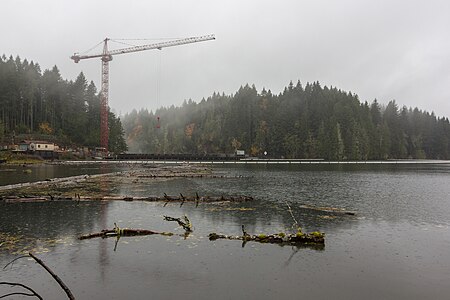Cushman Dam No. 2
Buildings and structures in Mason County, WashingtonDams completed in 1930Dams in Washington (state)Dams on the National Register of Historic Places in Washington (state)Energy infrastructure completed in 1930 ... and 11 more
Historic American Engineering Record in Washington (state)Historic districts on the National Register of Historic Places in Washington (state)Hydroelectric power plants in Washington (state)NRHP infobox with nocatNational Register of Historic Places in Mason County, WashingtonNeoclassical architecture in Washington (state)Tacoma Public UtilitiesUnited States power company damsUse mdy dates from August 2023Washington (state) Registered Historic Place stubsWashington (state) building and structure stubs

Cushman Dam No. 2 is a hydroelectric dam on the North Fork of the Skokomish River in Mason County, Washington, United States, forming Lake Kokanee. Built in 1930, its three 27,000 kilowatt generators provide 233 million kilowatt-hours annually to the Tacoma Power system. Along with Cushman Dam No. 1, it is part of Tacoma Power's Cushman Project. Construction began in 1929 and power production began in December 1930. The dam is 575 feet (175 m) long, 8 feet (2.4 m) wide at the top and 40 feet (12 m) at the base. It is 235 feet tall. Its reservoir, Lake Kokanee, is 2 miles (3.2 km) long.
Excerpt from the Wikipedia article Cushman Dam No. 2 (License: CC BY-SA 3.0, Authors, Images).Cushman Dam No. 2
Lower Lake Road,
Geographical coordinates (GPS) Address Nearby Places Show on map
Geographical coordinates (GPS)
| Latitude | Longitude |
|---|---|
| N 47.397666 ° | E -123.201242 ° |
Address
Lower Lake Road
Lower Lake Road
Washington, United States
Open on Google Maps







